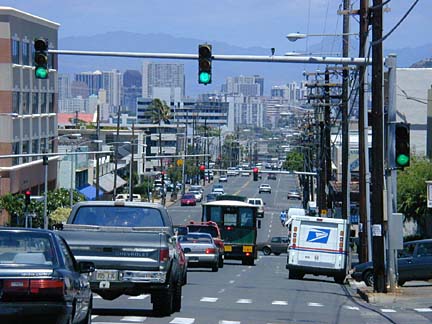Advertisement - Click to support our sponsors.


Ridership on the experimental Kaimuki-Kapahulu-Waikiki Trolley is "not as big as we expected" in its first three months of service, said Ginny Meade, an organizer with the group that helped conceive it. Kaimuki trolley hopes
to lure more ridersBy Pat Gee
Star-BulletinBut more promotions are under way.
Here are the ridership numbers according to City Councilman Duke Bainum's office:
The trolley runs every half hour from 6 a.m to 10 p.m.In August, the lowest number was 31 riders per day and the highest 162.
In September, the range was 70 to 163.
In October, the range was 83 to 166.
A blessing was held Oct. 27 for the city-subsidized shuttle, which Meade said is nicknamed "our neighborhood trolley" because its purpose was to circulate tourists and residents, and increase business in these three communities.
The idea was to make it easy for tourists to buy less-expensive groceries at Market City or go on "treasure hunts" in the little stores in Kapahulu and Kaimuki, she said. At the same time, "the aging community in Kaimuki /Kapahulu" can take advantage of the "one-hop transportation" to the Waikiki Community Center for senior citizens and the Waikiki Health Center on Ohua Avenue.
Residents also can use the trolley to enjoy the entertainment and restaurants in Waikiki without having to worry about parking, Meade added.
So far, the trolley has been used by residents for "joy riding" as well as by people who have jobs in Waikiki, who can get to work faster without transferring to another bus.
The Greater East Oahu Community Alliance plans to provide docents on the trolleys, advertise in "This Week" tourism publication for Waikiki readers, and distribute a brochure in the near future, she said.
That's good news to D.J. Colbert, co-owner of Prosperity Corner, a metaphysical gift shop, which was in Waikiki for 15 years and moved to Kaimuki 8 years ago.
Colbert is frustrated that a lot more has not been done by the city to promote the trolley, and the community will lose it after the experimental run is over after one year.
"Every time a trolley passes by with no one on it, it pains my heart," she said. "Very, very few riders are on it, and half the day, no one is riding on it."
She said a group of merchants spent $13,000 to produce a television advertisement that ran twice a day in mid-October, and they noticed an increase in business after that. The ad promised that upon seeing a trolley receipt, a merchant would pay for the $1-a-head trip back to Waikiki -- "That's good business," Colbert said.
She has repeatedly asked for permission to put advertising on the trolley itself, and that docents be put on the bus to tell about the area's history or ongoing activities, or at least have the drivers point out the businesses as they pass by.
"And why isn't there Hawaiian music on the bus?"
The trolley could be self-sufficient if there was enough publicity, urging that the city keep "bombarding people" with ads, Colbert said.
"Let's not throw this thing away," she said. "The trolley is a great idea. If tourism is our (mainstay), we need to move people around our island. Let's not just sell Waikiki. There are so many great places around here," she said.
Bainum said, "The numbers are not where we want them to be, but they're not surprising." He anticipates a "good increase" in riders to occur about now from advertising done in mid-October in "This Week."